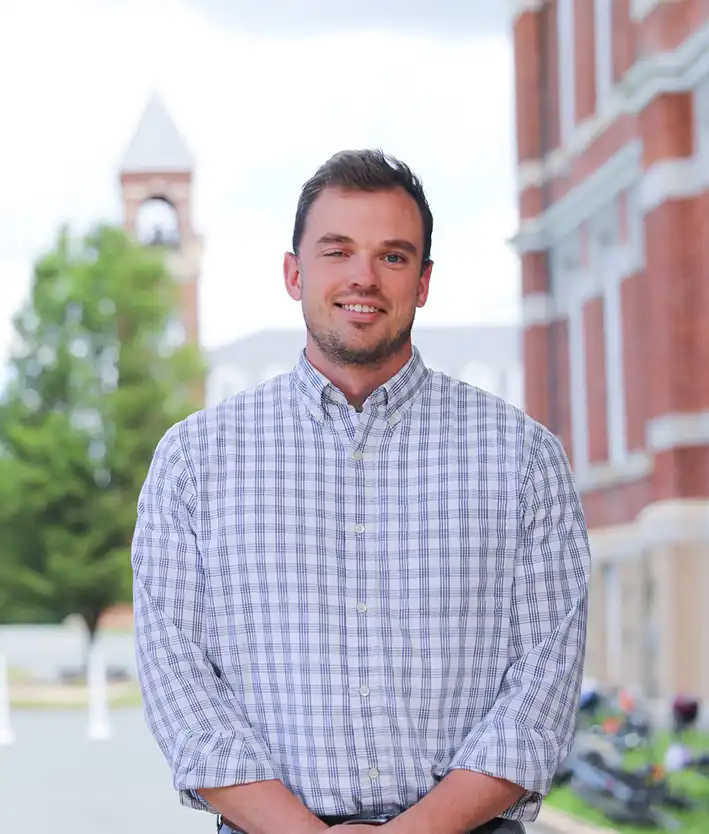Forest Service fellow finds 1940s documentation of crayfish introduction in Montana
Meet Hampton Kennedy

Hampton Kennedy discovered the history behind signal crayfish introduction in Montana by looking deep into archives as old as Lewis and Clark’s expedition. (Photo credit: Peter Hufnagel, Miller School of Albemarle)
It takes an interdisciplinary team to unravel the numerous questions science brings to the table, and even disciplines outside of science, technology, engineering and mathematics (STEM) serve an important role in answering those questions. For Hampton Kennedy, that discipline is history, and environmental history offered him a combination of two things he enjoys deeply: learning about the past and the great outdoors.
Kennedy earned his bachelor’s degree in history and social studies education from Appalachian State University and his master’s in American history from Norwich University. He believes history could make a real change in the world, so he became a United States Department of Agriculture (USDA) Forest Service (FS) Research Participation Program fellow. Alongside his mentor, Susan B. Adams, and other interdisciplinary collaborators, Kennedy became a part of a research project looking to discover the origins of a species of crayfish in Montana, called signal crayfish.
Few studies had been done on crayfish in Montana prior to this project. However, determining whether or not signal crayfish are a native species in Montana or introduced affects how ecologists manage their presence. Kennedy set out to find references to crayfish in Montana by starting with the oldest records through the 1960s, including records from known individuals who traveled through or settled in the state, such as Lewis and Clark. At first, there were no records of crayfish in Montana, despite documents showing their presence elsewhere in the Columbia River Basin, notably just over the mountains in Idaho. But then Kennedy saw a change.
“There was noticeable and almost sudden reporting of crayfish in western Montana newspapers in the 1930s. A smoking gun article from 1944 concluded that the sudden appearance of crayfish in the Bitterroot River was the result of two individuals who had imported 1,000 live Columbia River crayfish to use as fish food in their bass ponds about seven years earlier,” Kennedy explained. “The absence of mentions of crayfish in the area prior to the 1930s, and the sudden explosion of sources referring to them after, was very supportive of our conclusion that signal crayfish were most likely introduced to the western part of the state and therefore not native.”
Kennedy’s mentor noted that only 50 years after the initial introduction of the signal crayfish, knowledge of their introduction had been lost, leaving modern biologists to assume they were native. “It took a diligent historian to unearth the information,” Adams said.
Kennedy was amazed how much went into answering what sounded like a simple question. The research felt more like an investigation, Kennedy observed, because of how many varied sources he had to scour to find this information, which may have numbered more than 10,000 pages of text. He thanked his mentor for introducing him to freshwater ecology and her guidance on publishing the findings. The research was shared as an article in Wiley Interdisciplinary Reviews titled “Interdisciplinary Approaches Improve Understanding of Cryptogenic Species: A Historical Case Study of Crayfish in Montana, USA.”
Kennedy recommends the ORISE Forest Service program and encourages future scientists to trust in their mentors and ask questions, because the knowledge gained from the collaborative process is incredibly beneficial to one’s future career path. For him, the program helped expand his view on just how much history affects the present and inspired lesson plans for his own teachings.
“My time with ORISE has given me new ideas on how to coordinate with educators of different disciplines and encourage multidisciplinary education. I’ve also made the environment a central theme to my U.S. history courses. Finally, I think being on the receiving end of the manuscript peer review process has made me better at offering students more constructive feedback on their own writing,” Kennedy concluded.
Kennedy continues his work as an educator at the Miller School of Albemarle, a private, coeducational boarding school in central Virginia, founded in 1878. He teaches U.S. history and U.S. government and politics. He recently supervised a student-led archival project uncovering the architectural and environmental history of the school from the school archives in preparation for hosting the Historic Virginia Garden Week on campus. Outside of the classroom, he’s often fly fishing or canoeing on the rivers of Virginia.
The Forest Service Research Participation Program is funded by USDA and is administered through the U.S. Department of Energy’s (DOE) Oak Ridge Institute for Science and Education (ORISE). ORISE is managed for DOE by ORAU.

